Howard Andrew Jones's Blog, page 40
September 25, 2015
The Coming of Conan Re-Read: “Iron Shadows in the Moon”
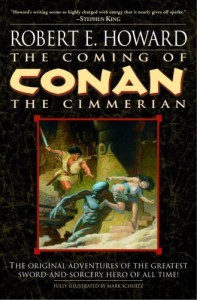 Bill Ward and I are reading our way through the Del Rey Robert E. Howard collection The Coming of Conan. This week we’re discussing “Iron Shadows in the Moon.” We hope you’ll join in!
Bill Ward and I are reading our way through the Del Rey Robert E. Howard collection The Coming of Conan. This week we’re discussing “Iron Shadows in the Moon.” We hope you’ll join in!
Bill: “Iron Shadows in the Moon” (retitled “Shadows in the Moonlight” for its Weird Tales and some subsequent appearances) contains everything most readers associate with a classic Conan tale: a beautiful female sidekick, the mysterious ruins of a forgotten race, supernatural peril, the clash of civilization and barbarism, subhuman monsters, and, above all, Conan being Conan. REH is firing on all cylinders at this point in his work on Conan and, if a few subsequent stories sometimes seem a bit like formulaic echoes of this story, it’s for good reason, as these elements all come together to tell a really terrific adventure.
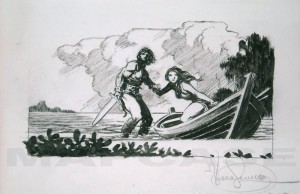
Mark Shultz
Howard: Given how often you and I have agreed on the stories we read it’s sort of strange to come to this one with a different opinion. While I agree that REH’s writing is smooth as silk on this one, I’m not sure I’d call it terrific. Patrice Louinet calls this — and the two that follow — one of the routine Conan stories. It’s not one of my favorites. It’s got some moments I like, but it’s not one I return to, unlike “Black Colossus” or even the one that follows, “Xuthal of the Dusk.” I thought at first it might be because I didn’t like seeing Conan from a different perspective, but I think it’s more that he feels less like the star and more like the love interest in Olivia’s story.
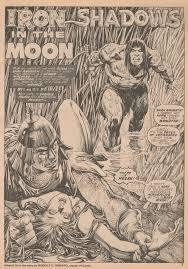 Bill: I wouldn’t rate it as a favorite, either, but I really enjoy all the elements at work in this piece, and the ending really resonates with me and sticks in my memory. There is actually quite a lot going on in “Iron Shadows in the Moon,” but the pace never flags and the various disparate threads are woven together with great skill. Conan is once again introduced through the eyes of a civilized person — as in “Black Colossus,” we have another princess, though Olivia’s circumstances are much different than Yasmela’s — who initially sees Conan in less-than-respectable form. Last time he was drunk and carousing, but here he is feral, covered in swamp filth and burning with hatred. Olivia, having escaped from the harem of the vile Shah Amurath, is very lucky indeed to meet the worst enemy Amurath ever made in the form of Conan, but she certainly doesn’t realize that when he comes stalking out of the swamp like an ogre.
Bill: I wouldn’t rate it as a favorite, either, but I really enjoy all the elements at work in this piece, and the ending really resonates with me and sticks in my memory. There is actually quite a lot going on in “Iron Shadows in the Moon,” but the pace never flags and the various disparate threads are woven together with great skill. Conan is once again introduced through the eyes of a civilized person — as in “Black Colossus,” we have another princess, though Olivia’s circumstances are much different than Yasmela’s — who initially sees Conan in less-than-respectable form. Last time he was drunk and carousing, but here he is feral, covered in swamp filth and burning with hatred. Olivia, having escaped from the harem of the vile Shah Amurath, is very lucky indeed to meet the worst enemy Amurath ever made in the form of Conan, but she certainly doesn’t realize that when he comes stalking out of the swamp like an ogre.
Howard: And it’s the first part of this story I like best. The brutal combat with Shah Amurath is a real blast, and we get the great “seeing Conan through someone else’s eyes” moment that you already mentioned. And then, when they head out on the rowboat, we get that gift of a moment that’s equal to some of the passages in Howard’s finest writing, where “Her silent companion was etched vaguely against the softer darkness. There was no break or falter in the rhythm of his oars; he might have been a phantasmal oarsmen, rowing her across the dark lake of death…”
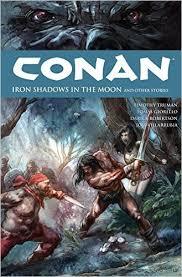 And even before that there’s another wonderful juxtaposition of Conan’s simple moral code and that of civilization, because his people would never have sold a child into slavery.
And even before that there’s another wonderful juxtaposition of Conan’s simple moral code and that of civilization, because his people would never have sold a child into slavery.
Bill: That’s a great moment in the ongoing conversation REH is having about civilization and barbarism. Despite her fear of the barbaric Cimmerian who, naked and reeking and armed only with a sword, handily defeats (and mutilates) an armored and skilled swordsmen before her eyes, Olivia joins Conan on his adventure, rightly recognizing that to stay behind is to invite death from Amruth’s men. Conan, having settled the score for the death of his Free Companions — a Cossack-like group of freebooters — is eager to get out of Turan. The two find themselves on an island in the Vilayet Sea, where they are stalked by a vicious man-ape, run afoul of pirates, and uncover an ancient evil.
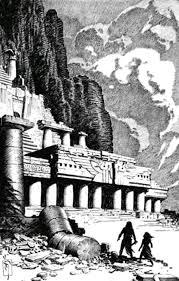
Mark Shultz
Olivia, like Yasmela before her and many subsequent beautiful companions, is more than just a bid for the Weird Tales cover story. She serves as a foil, letting us see Conan through civilized eyes, giving us a contrasting view of the character. This can be simply practical, as in the case of Olivia observing Conan’s duel with the pirates and subsequent capture, but far more its about giving the reader characterization we would not otherwise have. Conan is fairly scary when we first meet him, but we wouldn’t really see it unless there was another character to react to his bestial state. As Olivia comes to trust, rely on, and eventually love Conan, we see those qualities at the core of his character that go beyond the superficial. Scantily clad chicks are wonderful eye-candy, but if that’s all they ever were in these stories REH would not be the writer we know him to be.
And, when it comes to it, Olivia is really quite brave and useful — after all she rescues Conan when he is captured by pirates. How terrifying would such an action be, sneaking through a room full of sleeping pirates and soon-to-be-awakened iron demons? Much as Conan is humanized by his contact with Olivia, so to is Olivia emboldened by the man who can row all night without sleep, speed her from the path of a deadly projectile, and defeat a pirate captain in single combat. When she witness the climactic fight between Conan and the psychotic man-ape that has been stalking them, Olivia feels she is watching a battle between two wild animals — but Conan, wild and dangerous as he is, no longer repels her, he is in fact the only reliable and safe thing in her life.
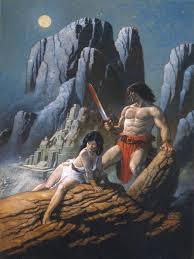
Mark Shultz
Howard: That’s a really excellent point — Olivia is quite brave. On the other hand, I was a little surprised Conan ended up getting captured as he did. It felt more like a plot point than something evolving from an action Conan would take, or that it was convenient for Olivia to show her bravery. Normally Conan wouldn’t have needed any help in this situation at all.
Bill: Well, I don’t necessarily disagree with that, but I saw it as an example of Conan being both desperate and, strangely, trusting. He obviously knows the pirate code, and I think he’s giving them more credit as honorable men than they deserve — perhaps thinking them something more akin to the Free Companions he has recently been serving with. It’s also a sling bullet that fells him, ranged weaponry always seeming to Conan a bit dishonorable. Sure, it’s a plot point, but I think its not unreasonable given what we know of Conan’s character.
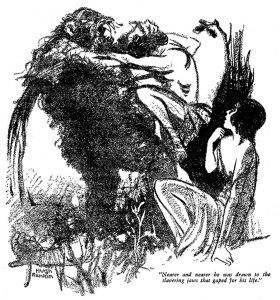 “Iron Shadows in the Moon” ends on a triumphant note with a very memorable scene. From a swamp-rat-eating fugitive, Conan makes himself captain of a pirate vessel and crew, and he even has his very own “Queen of the Blue Sea” to adventure by his side. I couldn’t help but think of “Queen of the Black Coast” when reading that, of the very different, but parallel, situation Conan found himself in in that story. Which only reinforces one of the central themes of Conan’s life, the ups and downs of his tumultuous adventuring, with Conan, above and through it all, content to live life as it comes — but always on his own terms.
“Iron Shadows in the Moon” ends on a triumphant note with a very memorable scene. From a swamp-rat-eating fugitive, Conan makes himself captain of a pirate vessel and crew, and he even has his very own “Queen of the Blue Sea” to adventure by his side. I couldn’t help but think of “Queen of the Black Coast” when reading that, of the very different, but parallel, situation Conan found himself in in that story. Which only reinforces one of the central themes of Conan’s life, the ups and downs of his tumultuous adventuring, with Conan, above and through it all, content to live life as it comes — but always on his own terms.
Howard: Yeah, I dug that he can shift and adapt to whatever situation he’s faced with. He’s still completely admirable. On the other hand, I was never completely absorbed or fascinated by the mystery on the island. I was wanting… something more. Sure, me and everyone else reading this could probably tell that the iron statues were going to come to life… but we didn’t really get to see much of that. I craved something more inventive. He did get a really great fight scene with the giant ape thing, though. And come part IV I thought he did a nice job maneuvering the pirates.
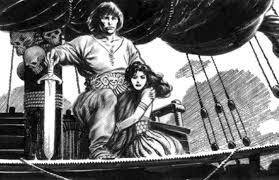
Mark Shultz
Bill: I liked that the statues came to life off-stage, to me that heightened their impact. I felt they were, in a way, a fun bit of misdirection: its the ape and pirates Conan has to deal with, but the statues loom like a ticking time bomb — or like an ‘iron shadow’ — over everything. I thought their history, told in a dream to Olivia, was also very cool — and evil race cursed by a god whose child they sacrificed. In the end, I wouldn’t rate this as top tier Conan but I think it’s got enough going for it in terms of craft and story and character elements to elevate it above the formulaic. The ending alone is worth the price of admission.
Howard: It DOES end on a hopeful note. I wonder if REH had planned to write more tales with Olivia on the Blue Sea with Conan, or if he knew from the start this was going to be the one and only?
Oh, hey, I almost forgot the parrot. You notice that he says something about ‘xuthalla?’ Crafty, prescient parrot that, especially since that’s almost the name of the city in our next outing, and part of the original title as well. I credit the mispronunciation to his parrotish accent. Tune in next week for “Xuthal of the Dusk!”
September 23, 2015
Link Day
 I remain crazy busy doing writer and house dad things, so I have little that’s especially clever. I’ll still do my best to entertain you today.
I remain crazy busy doing writer and house dad things, so I have little that’s especially clever. I’ll still do my best to entertain you today.
First, giant-sized hounds. Beware!
Second, I want to take a train across the U.S. like this. Except I’d probably start from Chicago and go west. But you get the idea.
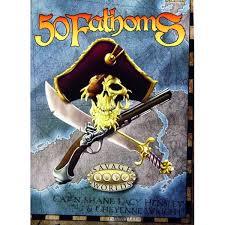 Third, I rewarded myself with downtime Friday night and Saturday evening and re-read the Savage Worlds campaign 50 Fathoms. Man, is that stuffed with great pirate adventures. I really, really have to find a way to run that. A problem, since I haven’t had a working group in a while. Don’t take my abbreviated word for it — check out the reviews at the link. I liked it so well on PDF that I bought a physical copy. But then, I hate reading PDFs. I think 50 Fathoms is fun to read even if you’re not a gamer. Well, at least if you’re a writer or dig pirates.
Third, I rewarded myself with downtime Friday night and Saturday evening and re-read the Savage Worlds campaign 50 Fathoms. Man, is that stuffed with great pirate adventures. I really, really have to find a way to run that. A problem, since I haven’t had a working group in a while. Don’t take my abbreviated word for it — check out the reviews at the link. I liked it so well on PDF that I bought a physical copy. But then, I hate reading PDFs. I think 50 Fathoms is fun to read even if you’re not a gamer. Well, at least if you’re a writer or dig pirates.
Fourth, there’s a great sale going on at my favorite clothes store, SCOTTeVest. I keep meaning to blog about how much I love their shirts and khakis, but this has never been a clothing blog. Anyway, some great stuff is 40% off. I’m definitely going to pick up another one of their pocket-laden safari type shirts. I love not having to shove my notebook into my jeans pocket.
September 21, 2015
Two Cool Things
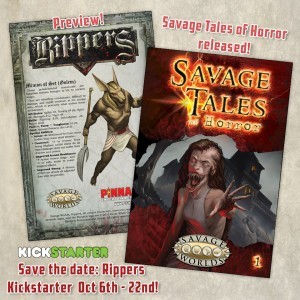 I’ve mentioned before that I really enjoy the Savage Worlds game system. I’ve loved every official release, although the only setting I’ve yet played for any length of time is the Savage Worlds of Solomon Kane. I talk about the game here, here, and here.
I’ve mentioned before that I really enjoy the Savage Worlds game system. I’ve loved every official release, although the only setting I’ve yet played for any length of time is the Savage Worlds of Solomon Kane. I talk about the game here, here, and here.
I ended up liking what Savage Worlds had done so much that I threw my hat in the ring to write some adventures for them. The first will be available in only a few months as part of a trilogy of new horror adventure books.
Volume 1 is out already, and features another Solomon Kane tale, as well as a bevy of terrifying adventures. Check it out here.
My own story turns up in Volume 3, and is probably the closest I’ll ever get to writing Solomon Kane pastiche. When I ran the adventure for my little group I actually had Solomon Kane himself turn up to help, although he himself doesn’t appear in the adventure I wrote. (In case you’re curious, though, he’s statted up in the main book.)
I’m really enjoying working with the folks at Pinnacle, aka the Savage Worlds people, and I hope soon to talk about a longer project I’m wrapping up for them.
For now, though, the only other news I have is that the first review of my new book is in, and it’s a pretty nice one. Take a look here, at Swords’ Edge.
September 18, 2015
The Coming of Conan Re-Read: “Black Colossus”
 Bill Ward and I are reading our way through the Del Rey Robert E. Howard collection The Coming of Conan. This week we’re discussing “Black Colossus.” We hope you’ll join in!
Bill Ward and I are reading our way through the Del Rey Robert E. Howard collection The Coming of Conan. This week we’re discussing “Black Colossus.” We hope you’ll join in!
Howard: Maybe it’s not as deep, or as soulful, as some that are more routinely mentioned by Howard scholars, but this is one of my favorite Conan stories. This is the work of a master who knows exactly how far to push every moment, and understands exactly what his audience wants. Robert E. Howard is in complete control of this narrative from beginning to end.
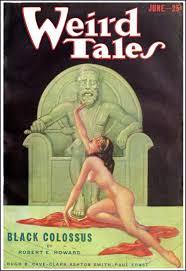 Look at that great opening, with its master thief and the tomb hung with menace. We witness the skill and capability of Shevatas, which makes it even more worrisome when it’s clear that he’s dead or worse by the segment’s end — an end that occurs off camera, to heighten suspense. And then, in section 2, we get Yasmela. REH was perfectly capable of showing us strong, independent women, but Yasemela isn’t really one of them. She’s a pampered princess in need of protection, but determined to help her nation… AND she’s gorgeous and prone to being naked. REH had to have known that red blooded heterosexual male readers would feel an instinctual desire for her, as well as a compulsion to protect her both from the creepy sorcerer and her other worries. We admire her pluck and courage and know that she needs someone (not us, though we might wish that) to rescue her. Yeah, she might not be real, but REH is playing us guys like a musician with a fiddle. He KNOWS the notes to hit to get the effect on us he likes.
Look at that great opening, with its master thief and the tomb hung with menace. We witness the skill and capability of Shevatas, which makes it even more worrisome when it’s clear that he’s dead or worse by the segment’s end — an end that occurs off camera, to heighten suspense. And then, in section 2, we get Yasmela. REH was perfectly capable of showing us strong, independent women, but Yasemela isn’t really one of them. She’s a pampered princess in need of protection, but determined to help her nation… AND she’s gorgeous and prone to being naked. REH had to have known that red blooded heterosexual male readers would feel an instinctual desire for her, as well as a compulsion to protect her both from the creepy sorcerer and her other worries. We admire her pluck and courage and know that she needs someone (not us, though we might wish that) to rescue her. Yeah, she might not be real, but REH is playing us guys like a musician with a fiddle. He KNOWS the notes to hit to get the effect on us he likes.
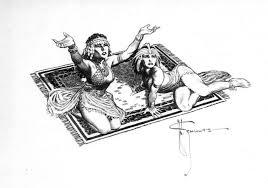 Bill: She’s an interesting parallel to Bêlit. Both are in positions of power, and both admire and rely on Conan because he is a cut above their own subjects. Yasmela has seen many strong men before in her capacity as ruler, but none such as Conan, whom she senses is no supplicant; he has never knelt before any man. Mitra certainly knows how to pick them!
Bill: She’s an interesting parallel to Bêlit. Both are in positions of power, and both admire and rely on Conan because he is a cut above their own subjects. Yasmela has seen many strong men before in her capacity as ruler, but none such as Conan, whom she senses is no supplicant; he has never knelt before any man. Mitra certainly knows how to pick them!
Howard: Man, does Conan enter in style this time, from stage right. The events are in motion, the pieces introduced, and then he’s there, larger than life and ready to wade into adventure. Well, first he’s ready to sweep Yasmela to bed, but once he sees what’s under way, he speaks plainly and wisely. There are so many great, simple lines here that reveal Conan’s character. I love how Conan talks tactics: “It’s no more than sword-play on a larger scale. You draw his guard, then – stab, slash! And either his head is off, or yours.”
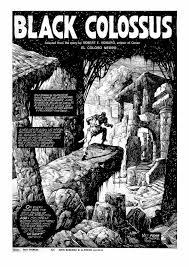 Bill: And when Yasmela’s generals get their first look at him, he’s half-drunk and gnawing on a beef bone. From that great introduction onward the story really plays with the class and culture differences of the various players, until the final battle itself is a clash between salt-of-the-earth professional soldiers and a nobleman-led force under Nathok the Veiled One — the great Thugra Khotan, returned after three thousand years to have his vengeance on the descendants of the Hyborian hordes who crushed his old empire.
Bill: And when Yasmela’s generals get their first look at him, he’s half-drunk and gnawing on a beef bone. From that great introduction onward the story really plays with the class and culture differences of the various players, until the final battle itself is a clash between salt-of-the-earth professional soldiers and a nobleman-led force under Nathok the Veiled One — the great Thugra Khotan, returned after three thousand years to have his vengeance on the descendants of the Hyborian hordes who crushed his old empire.
Howard: Really good point. This is blue collar versus the upper crust. This isn’t a later generation’s “promised stable boy/forgotten prince.” Conan rises to lead because of his own skills and inborn traits.
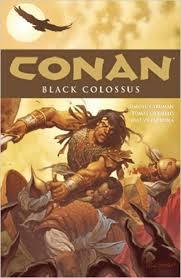 Come chapter IV are some very fine mass battle scenes and descriptive passages of great excellence. Savor these lines that would cost hundred of thousands of dollars to film: “In the early haze of dawn the streets of Khoraja were thronged by crowds of people who watched the hosts frizzing from the southern gate. The army was on the move at last. There were the knights, gleaming in richly wrought plate-armor, colored plumes waving above their burnished sallets. Their steeds, caparisoned with silk, lacquered leather and gold buckles, caracoled and curvetted as their riders put them through their paces. The early light struck glints from lance points that rose like a forest above the array, their pennons flowing in the breeze.”
Come chapter IV are some very fine mass battle scenes and descriptive passages of great excellence. Savor these lines that would cost hundred of thousands of dollars to film: “In the early haze of dawn the streets of Khoraja were thronged by crowds of people who watched the hosts frizzing from the southern gate. The army was on the move at last. There were the knights, gleaming in richly wrought plate-armor, colored plumes waving above their burnished sallets. Their steeds, caparisoned with silk, lacquered leather and gold buckles, caracoled and curvetted as their riders put them through their paces. The early light struck glints from lance points that rose like a forest above the array, their pennons flowing in the breeze.”
Bill: And even more great word-painting when the battle itself occurs. That does remind me, though, of one thing I’ve never been crazy about in the Conan stories, and that’s the anachronistic technology in them. The french chivalric lexicon of armor pieces that is on display in this and some of the other stories (“they brought harness to replace Conan’s chain-mail — gorget, sollerets, cuirass, pauldrons, jambes, cuisses, and sallet.”) and some other anomalies like arbalests, is right out of the High Middle Ages, and just never feels right to me. Conan illustrators must agree, as I can’t recall ever seeing him in 15th century plate armor, indeed the Del Rey edition’s beautiful full page picture depicting the scene you quoted above, Howard, is distinctly bronze age Assyrian or Babylonian in character. It’s a minor criticism of something that never truly detracts from the story, and I will admit that in other respects certain anachronistic aspects of the Hyborian Age only add to its charm, but it does somewhat undermine my suspension of disbelief — I read those things and think more about REH’s influences than Conan’s world.
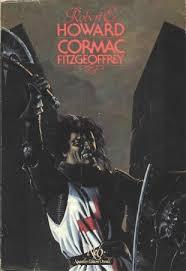 Howard: That’s something I notice but rarely pay much heed to. I guess I just gloss over the armor issue as I roll my eyes only a little at the reference to what sounds like age of sail ships in other Conan tales. The thing that does grate on me in Howard’s fiction is the occasional info dump/plot advancement through dialogue, even though I know that it was standard at the time. (I’ve read plenty of old fiction that does the same.) A lot of the time REH doesn’t lean on those techniques at all, so that when he does it really stands out. For instance, I’ve never much cared for the first story he wrote about Cormac Fitzgeoffrey because it’s weighted down with backstory through conversation that doesn’t sound remotely real. And yet within a little while after crafting it REH turned around and wrote some of the best historical fiction ever set to paper, completely free of any sort of hint of that.
Howard: That’s something I notice but rarely pay much heed to. I guess I just gloss over the armor issue as I roll my eyes only a little at the reference to what sounds like age of sail ships in other Conan tales. The thing that does grate on me in Howard’s fiction is the occasional info dump/plot advancement through dialogue, even though I know that it was standard at the time. (I’ve read plenty of old fiction that does the same.) A lot of the time REH doesn’t lean on those techniques at all, so that when he does it really stands out. For instance, I’ve never much cared for the first story he wrote about Cormac Fitzgeoffrey because it’s weighted down with backstory through conversation that doesn’t sound remotely real. And yet within a little while after crafting it REH turned around and wrote some of the best historical fiction ever set to paper, completely free of any sort of hint of that.
I suppose that we all come to fantasy fiction, or any fiction, really, with the ability to glory in some things and ignore others, and our enjoyment of one kind of genre depends in part upon what we can overlook. My wife and I enjoy a lot of the same sorts of stories, and I was both thrilled and surprised that she loved Harold Lamb’s tales of Khlit the Cossack. But she doesn’t care for Robert E. Howard in part because she finds the writing “purple.” Whereas I think REH at his finest is an incredible prose stylist. And I do think that Howard’s writing does appeal more to men than women, although such a broad brush comment shouldn’t be read as me saying that no women enjoy his work.
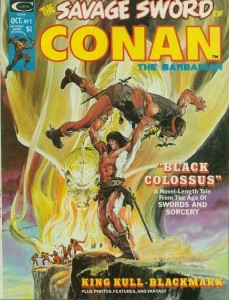 But I’ve drifted off topic. To return to “Black Colossus,” I think too often in fiction all the rulers and villains and principal characters are brilliant schemers. That’s just not as interesting from a sociological standpoint. Lots of history was made because people weren’t clever enough to make good choices. Student of history that he was, Robert E. Howard knew that battles hinged sometimes on poor or very human decisions. I love that the arrogant count Thespides, the knight, is more certain of victory depending upon his station and status than an actual knowledge of tactics, and I love that Yasmela, unschooled in warfare, thinks Conan in error for not supporting the count’s attack.
But I’ve drifted off topic. To return to “Black Colossus,” I think too often in fiction all the rulers and villains and principal characters are brilliant schemers. That’s just not as interesting from a sociological standpoint. Lots of history was made because people weren’t clever enough to make good choices. Student of history that he was, Robert E. Howard knew that battles hinged sometimes on poor or very human decisions. I love that the arrogant count Thespides, the knight, is more certain of victory depending upon his station and status than an actual knowledge of tactics, and I love that Yasmela, unschooled in warfare, thinks Conan in error for not supporting the count’s attack.
Bill: It’s wonderful stuff, as is the resultant exchange between Conan and his former mercenary commander, Amalric, who remarks that Thespides’ hot-headed charge is the sort of thing that Conan used to get up to. Conan agrees, but says that was when he was only worried about his own hide, now he’s responsible for others. Here Conan’s essential decency and honor feeds right into his maturation — this battle is his first command, and it’s really a freak of fortune that Conan is even in this position. But he’s smart, and he respects his fellow soldiers, having emerged just days before from their ranks himself, and all of that factors into him growing into a position of responsibility. Earlier, there is also reference to how kingly he looks all decked out in his new armor, something Conan would retain in the back of his mind for years. He’s growing as a character right before our eyes, a rather amazing thing considering these are stand-alone stories told in no particular order.
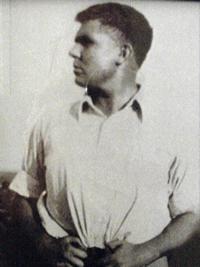
Robert E. Howard
Howard: Oh yeah. I enjoy Amalric, and how we learn more about Conan through him. Again we see REH’s ability to give us a character for just a few brief scenes and make us fond of him — even though, if you peer behind the curtain, you can sort of see that Amalric’s real purpose is just to provide information or show us Conan in a different light. A lesser writer would have written him without managing to make us care about the character.
Bill: When we at last get to the climactic battle, it’s Conan’s patience, cunning, and cool that win the day. He stops a route of his hillman with his own raw presence, doesn’t commit to the battle when Thespides launches his foolish assault, and has the sense to risk a flank attack with Amalric when he sees that only a desperate move can bring victory. His counter-charge into the teeth of Nathok’s horde is done with makeshift cavalry — all the footman and mercs who never were themselves knights, hammering into a horde of aristocrats and their, possibly enchanted, slave soldiers. In the end, it’s ‘blue collar’ professionals led by a bone-gnawing pragmatist that route the proud charioteers and desert fanatics of the long-lost Sorceror-King.
Howard: It’s a textbook example of how to write mass battle sequences. Anyone wanting to write a battle scene with ancient or medieval armies needs to read this tale, or at least that final chapter. I think I could read it over and again and still be learning how its done.
My schedule precluded me from participating in any discussion this week, but I hope to drop by to see your own reactions to “Black Colossus” in the coming days. Next week, “Iron Shadows in the Moon.”
September 17, 2015
Justice League: Gods and Monsters
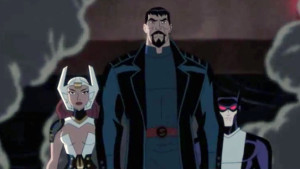 I don’t know that I’ve ever mentioned it on this blog, but I’m a huge fan of Batman: The Animated Series, Justice League, Justice League: Unlimited, and, to a lesser extent, Superman: The Animated Series, and Batman Beyond. I loved the animation style and (for the most part) the character designs, but most importantly — because a cool look matters not at all if the tales are poor — the storytelling. It was usually top-notch, head and shoulders above cartoons of the time and at least equal if not superior to the best modern cartoons as well.
I don’t know that I’ve ever mentioned it on this blog, but I’m a huge fan of Batman: The Animated Series, Justice League, Justice League: Unlimited, and, to a lesser extent, Superman: The Animated Series, and Batman Beyond. I loved the animation style and (for the most part) the character designs, but most importantly — because a cool look matters not at all if the tales are poor — the storytelling. It was usually top-notch, head and shoulders above cartoons of the time and at least equal if not superior to the best modern cartoons as well.
That’s why, when I learned there was a new Justice League movie being released with one of the most important of the original crew overseeing it (i.e. Bruce Timm) I immediately put the movie in the Netflix queue. I didn’t know anything much about it, except that it was with some kind of alternate Justice League.
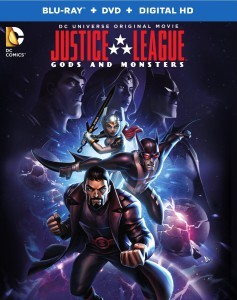 I watched Justice League: Gods and Monsters over the weekend, and boy, was that 72 minutes of grand adventure. I didn’t know what to expect. Turns out that there was all kinds of news about the movie, including three animated shorts, some tie-in comic books, and a whole blast of publicity.
I watched Justice League: Gods and Monsters over the weekend, and boy, was that 72 minutes of grand adventure. I didn’t know what to expect. Turns out that there was all kinds of news about the movie, including three animated shorts, some tie-in comic books, and a whole blast of publicity.
I’m not really tuned in to comic book or animated news these days because I’m running for so many deadlines, so I was completely surprised by what I saw. If you’re a fan of this stuff and you haven’t heard anything about it, take my advice and go watch it before reading any further, because I think walking into it unprepared was one of the best things that could have happened.
Seriously. If you like the DC Animated Universe and don’t know anything about this movie, stop reading, now, and go watch it. Don’t read anything more about it from me or anyone else!
Alright. So Bruce Timm decided to revisit The Justice League with alternate versions of the big three: Superman, Batman, and Wonder Woman. I kept thinking that this was going to be an alternate version of Earth that had unethical, criminal versions of the characters and that the real ones would show up and bash things into order. As Darian Jones says, turns out that no. And this alternate Justice League isn’t actually as evil as they first may seem, but they don’t really work very hard to pull their punches.
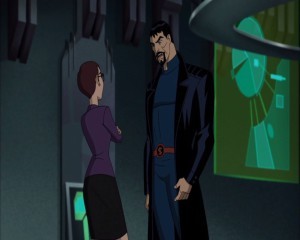
Superman chats with Lois Lane.
I honestly think I like the origin of two out of the three of them better than those of their counterparts in the regular DC universe. There’s so much new story potential with them. The DC Animated Universe did such a fantastic job with Batman that there’s no topping him. I enjoyed alternate Batman, but I loved this universe’s Superman and Wonder Woman.
We see Superman’s origin in the opening scenes, and it’s one I’m so familiar with that I wasn’t paying attention at first, assuming that I was just getting a re-hash. Remember General Zod, the Kryptonian maniac who in the DC Animated Universe is the villain trapped in the phantom zone? In THIS reality, it’s his son rather than the kindly Jor-El who gets rocketed to Earth. Rather than being found by the Kents, that child is discovered and raised by migrant workers. We don’t see the rest of Superman’s upbringing, but we can infer through various asides that it left him hardened and aloof, though not without compassion. He’s torn between the desire to set things right and simply take over and run the world properly.
A major portion of his character arc is learning that his father wasn’t a hero of Krypton, but the man responsible for its destruction because of his own obsession with power. Talk about a conflicted hero! The story potential from this version of Superman is so brilliant it emits sparks.
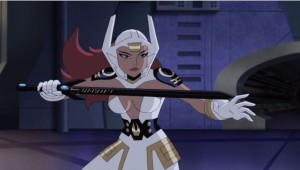 I was just as taken with alternate Wonder Woman. In some ways she’s more of a straight-up do-gooder than the others — but instead of being Diana Prince, raised on a hidden island, she’s a minor DC character I’d never heard of, the wife of Jack Kirby’s Orion, from the New Gods… except here she’s the widow, fled to Earth in disgust after her own family turned on her husband. She has a pretty remarkable, and awesome, sword that she wields to great effect.
I was just as taken with alternate Wonder Woman. In some ways she’s more of a straight-up do-gooder than the others — but instead of being Diana Prince, raised on a hidden island, she’s a minor DC character I’d never heard of, the wife of Jack Kirby’s Orion, from the New Gods… except here she’s the widow, fled to Earth in disgust after her own family turned on her husband. She has a pretty remarkable, and awesome, sword that she wields to great effect.
There are appearances by alternate versions of any number of DC mainstays, some in cameos and some in important parts, like Lois Lane (who seems to despise this Superman) and Lex Luthor.
In short, if you like this kind of thing, particularly the DC Universe, you’re REALLY going to like this thing. Go get it. I’m going to pick up a copy to own (which I almost never do) because I can imagine re-watching it. And I’ll be tuning in to see the ten new episodes that I hear are being produced next year and keep wondering whether or not they’ll be more five minute episodes like the three previous, or full 20 minute adventures.
I might even try the comic books, and I’ll keep fingers crossed that there will be another movie. Just as I used to imagine how much fun it must have been creating new villains for Batman Beyond inspired by the roles Batman’s villains used to play, I can’t help thinking of all the fun Timm must have had coming up with alternate takes on any number of DC stalwarts, and how much fun it will be to watch what he does with them. I hope he has plenty of opportunities to play in this sandbox.
Hell, I might even dream of writing for them, except I have plenty of projects on the burner already…
Here’s some related links.
Check out alternate Superman in this animated short. See if you can spot a different role for Captain Marvel’s long-time advisory.
Here’s an extremely well-written, well-considered review of the movie that I agree with almost completely.
September 14, 2015
Hyborian Map
Robert E. Howard scholar Barbara Barrett sent Bill and me copies of a nifty Hyborian Age map. She had some extra copies from Howard Days 2014 and sent some to the two of us via John O’Neill.
 Note the figure in the upper left, likely searching for some jeweled thrones to trod under his sandaled feet. I’m probably going to get this map framed — it’s just danged cool. Thanks, Barb!
Note the figure in the upper left, likely searching for some jeweled thrones to trod under his sandaled feet. I’m probably going to get this map framed — it’s just danged cool. Thanks, Barb!
September 11, 2015
The Coming of Conan Re-Read: “Queen of the Black Coast”
 Bill Ward and I are reading our way through the Del Rey Robert E. Howard collection The Coming of Conan. This week we’re discussing “The Queen of the Black Coast.” We hope you’ll join in!
Bill Ward and I are reading our way through the Del Rey Robert E. Howard collection The Coming of Conan. This week we’re discussing “The Queen of the Black Coast.” We hope you’ll join in!
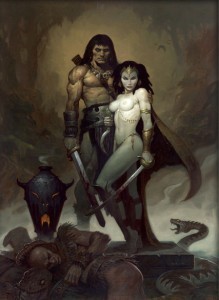
Brom’s art of the happy couple.
Bill: There’s a wonderfully vivid moment of stillness at the heart of “Queen of the Black Coast;” Conan sits high on the ruined pyramid of a vanished race as night falls over a scene of slaughter, the “black colossus” (which becomes the title of the next story) of the jungle a vast sea of darkness that enfolds him. He is as far away from any aid or comfort as we’ve ever seen him and far beyond the bounds of civilization, his lover lies dead on the ship they shared for years while the corpses of her pirate crew are scattered among the ruins, and a malignant evil that Conan has only glimpsed in a vision bides its time, waiting just as the Cimmerian, too, waits. Here is the man of “gigantic melancholies,” the man whose mind does not break, and, when the moon finally rises and the beasts rush upon him, the man of action.
It’s a strikingly effective scene that seems to synthesize everything that has come before in the story, and to draw out the reader’s anticipation of what is to come. It’s also an example of REH’s deft touch as a storyteller — in a tale that has been nothing but forward momentum since Conan first leaps his horse aboard a departing galley to escape the magistrates of Zingara, it’s a chance for the reader to catch their breath, to absorb the full importance of what has happened, and to look forward to the building climax. It’s the balancing point of the story, the hinge, and, for me, always one of the most unforgettable moments of a tale that is brimming over with exoticism and excitement, weirdness and adventure.
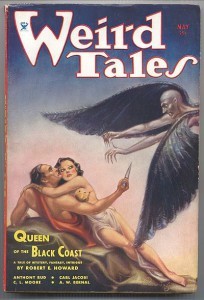 Howard: You’re absolutely right. Howard was all about the pacing, so much so that when he stumbles in other tales, even a little, it’s a shock. He didn’t just understand how to pace — and believe me, I’m positive that he put great thought into how to keep a story moving — he had an innate understanding of pacing, or it wouldn’t be so obvious even in his rough drafts. It’s almost always there, and it’s certainly present from the beginning in this story, pulling us forward.
Howard: You’re absolutely right. Howard was all about the pacing, so much so that when he stumbles in other tales, even a little, it’s a shock. He didn’t just understand how to pace — and believe me, I’m positive that he put great thought into how to keep a story moving — he had an innate understanding of pacing, or it wouldn’t be so obvious even in his rough drafts. It’s almost always there, and it’s certainly present from the beginning in this story, pulling us forward.
Bill: Agreed, and I think “Queen of the Black Coast” has one of the strongest openings so far in the series. Conan, much as he had in the beginning of “The Tower of the Elephant,” has run afoul of civilization’s incomprehensible ways. Again, it is his barbarian honor — in this instance the refusal to give up a friend — that leads to bloodshed (in the form of a murdered judge no less), and Conan must flee. Everything you need to know about Conan is provided in this tale, from a detailed physical description to his personal philosophy on points of honor and religion and, again, this is one of those stories that would serve as an excellent introduction to the character.
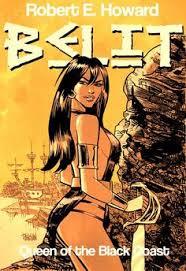 However, it is another character for whom this tale is famous, Bêlit, “untamed as a desert wind, supple and dangerous as a she-panther,” the titular “Queen of the Black Coast.” Neither the fainting damsel of the pulp tradition, nor the ridiculously masculinized warrior woman of so much hackneyed modern fantasy, Bêlit is a temptress who is worshiped as a goddess by her crew, but she is also a predator, a raider, and a strategist. She may indeed be a kind of sorceress, her sexuality alone commanding a kind of awe, and her own fierce love for Conan having a power that transcends the rational. In death, she saves Conan’s life, and what more explanation do we need for that feat other than that she said it would be so? She is a creature of iron will, and Conan is content for years to stay by her side, her equal in respect but her willing subordinate in other matters. She is the master pirate to whom Conan is apprenticed during what seems to me to be one of the most significant and formative periods of his life.
However, it is another character for whom this tale is famous, Bêlit, “untamed as a desert wind, supple and dangerous as a she-panther,” the titular “Queen of the Black Coast.” Neither the fainting damsel of the pulp tradition, nor the ridiculously masculinized warrior woman of so much hackneyed modern fantasy, Bêlit is a temptress who is worshiped as a goddess by her crew, but she is also a predator, a raider, and a strategist. She may indeed be a kind of sorceress, her sexuality alone commanding a kind of awe, and her own fierce love for Conan having a power that transcends the rational. In death, she saves Conan’s life, and what more explanation do we need for that feat other than that she said it would be so? She is a creature of iron will, and Conan is content for years to stay by her side, her equal in respect but her willing subordinate in other matters. She is the master pirate to whom Conan is apprenticed during what seems to me to be one of the most significant and formative periods of his life.
Howard: Indeed. And I’m not alone in wishing that Howard had written further of her. Alas, he did not, and we can only imagine other adventures he might have shared with her ourselves, or turn to the pastiche writers.
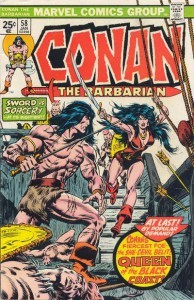 Bill: I would have loved that as well, but her scarcity does at least serve to heighten the mystique of her character. Bêlit can also be a polarizing character, unfortunately serving as a focus for whatever political or social hobbyhorse the critic wishes to brandish. To me she couldn’t be a clearer manifestation of H.Rider Haggard’s She, part of the tradition of colonial literature where lost pockets of civilization lie hidden in the blank spaces of the map, and adventurers can find themselves the overlords of exotic, technologically primitive, peoples. She commands a crew of islanders of the far south described as looking somewhat like Zulus, from whom she remains aloof, particularly sexually. Today’s race-obsessed bleaters will of course read some kind of racism into this, while missing the obvious narrative necessity of it. When one’s power is based on a sense of the other, one does not spoil it with intimacy. Officers don’t fraternize with enlisted, and gods-on-earth do not allow their human nature free reign. Daniel Dravot, while himself playing god, may have lost his head because of his interest in a native girl in Kipling’s “The Man Who Would Be King,” but ambitious, ruthless Bêlit would never make that same mistake.
Bill: I would have loved that as well, but her scarcity does at least serve to heighten the mystique of her character. Bêlit can also be a polarizing character, unfortunately serving as a focus for whatever political or social hobbyhorse the critic wishes to brandish. To me she couldn’t be a clearer manifestation of H.Rider Haggard’s She, part of the tradition of colonial literature where lost pockets of civilization lie hidden in the blank spaces of the map, and adventurers can find themselves the overlords of exotic, technologically primitive, peoples. She commands a crew of islanders of the far south described as looking somewhat like Zulus, from whom she remains aloof, particularly sexually. Today’s race-obsessed bleaters will of course read some kind of racism into this, while missing the obvious narrative necessity of it. When one’s power is based on a sense of the other, one does not spoil it with intimacy. Officers don’t fraternize with enlisted, and gods-on-earth do not allow their human nature free reign. Daniel Dravot, while himself playing god, may have lost his head because of his interest in a native girl in Kipling’s “The Man Who Would Be King,” but ambitious, ruthless Bêlit would never make that same mistake.
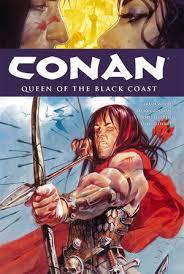 Howard: Oh, nicely argued, Bill.
Howard: Oh, nicely argued, Bill.
Bill: Much too can be said in criticism of her instant attraction, love really, for Conan — unless of course you’ve spent more than five minutes in the real world, where it happens all the time. Bêlit recognizes Conan for what he is immediately, a kindred spirit, as exceptional and gifted as she. It’s exactly what the Pirate Queen was waiting and hoping for — what most of us who haven’t found it are waiting for in our own mundane way. Perhaps a sharper critique could be leveled on the apparent lack of development of Conan and Bêlit’s love for one another in “Queen of the Black Coast,” but this, like so much else in these short tales, is handled not only with concision, but with a faith in the audience’s ability to understand these characters through their deeds alone. How do you not believe in a love that fights through death itself to save the life of the object of its devotion?
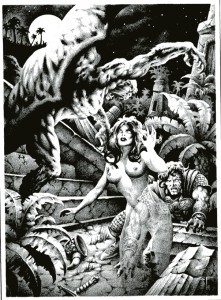
The art of Fabian.
And it is to Bêlit that Conan bares his soul, giving the following famous lines, one of the purest expressions of his character:
Let me live deep while I live; let me know the rich juices of red meat and stinging wine on my palate, the hot embrace of white arms, the mad exultation of battle when the blue blades flame and crimson, and I am content. Let teachers and philosophers brood over questions of reality and illusion. I know this: if life is illusion, then I am no less an illusion, and being thus, the illusion is real to me. I live, I burn with life, I love, I slay, and am content.
Content by her side, though all things must end. Does Conan feel as strongly for Bêlit as she does for him? This is not necessarily any clearer to us than it is to Conan, and again we see REH for the psychologically astute writer that he is, as well as one that knows that simply telling an audience everything is the surest way to make them not care. Conan gives Bêlit a King’s funeral, her pyre heaped with the wealth of an empire, the wealth that, of course, was her undoing. It’s an act of profound respect and, perhaps also, an act of rejection — not of the woman, but of her nature. Hung up to die by the precious necklace she had chosen from the loot of the lost city while her slaughtered crew is gnawed by hyenas, the Pirate Queen and everyone around her pays the price for daring to grasp at too much. Conan, the only survivor, has by the end of the story grown richer only in loss, with ship, treasure, and queen consumed in a single funeral fire.
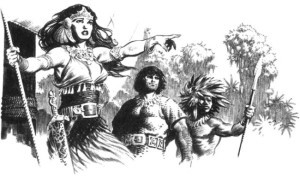
Art by Mark Schulz.
The above quote of Conan’s says nothing of wealth, ambition, or permanence. Conan, much later in life, takes for himself a kingdom when the opportunity presents itself, but he does not seek it out. Bêlit, I’d have to imagine, went about creating her own “kingdom” from the ground up, as a matter of policy, of ambitious and careful planning. And, unlike a later King Conan, she treats her subjects as disposable objects, and even the warnings of the man she loves are muffled by her fixation on the newly uncovered treasure. Ultimately, only her love for Conan survives death, her treasure gone down to mingle with her bones in the depths of the sea. Perhaps she should have learned from her lover to be content with what she had but then, of course, she would not have been Bêlit.
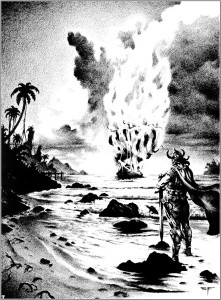 Howard: Bill’s comments were so inspired this week I have little to do apart from stand back and scratch my head and golf clap. I could point out that there’s some kick butt fight scenes, but that should really go without saying.
Howard: Bill’s comments were so inspired this week I have little to do apart from stand back and scratch my head and golf clap. I could point out that there’s some kick butt fight scenes, but that should really go without saying.
Bill: Thanks, Howard. There’s other great stuff as well that neither of us covered, a forgotten, non-human race devolved into a monstrous evil, a black lotus vision that is a brilliant way for REH to at once remove Conan from the action but allow him, and the reader, to see both the death of the crew and also the tale of the lost city itself, great character moments like Conan’s skill with the bow, a weapon that he nonetheless disdains as somewhat less than honorable … the list goes on. But, in the end, it really is Bêlit that looms largest.
Pirate one week, and general the next — join us here next Friday for “Black Colossus.”
September 9, 2015
Harold Lamb: Appreciation in Ukraine
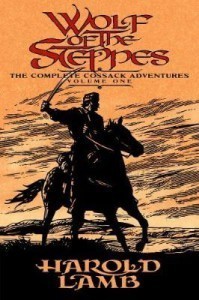 I’m deep in the writing mines all this week, but I emerged into the sunlight to let you in on a cool article I stumbled across featuring the talented Harold Lamb. Seems he’s recently been noticed in a Ukranian magazine article penned by Olek Veremko-Berezhny.
I’m deep in the writing mines all this week, but I emerged into the sunlight to let you in on a cool article I stumbled across featuring the talented Harold Lamb. Seems he’s recently been noticed in a Ukranian magazine article penned by Olek Veremko-Berezhny.
I especially like the image of Lamb drawn for the article.
September 4, 2015
The Coming of Conan Re-Read: “The Scarlet Citadel”
 Bill Ward and I are reading our way through the Del Rey Robert E. Howard collection The Coming of Conan. This week we’re discussing “The Scarlet Citadel.” We hope you’ll join in!
Bill Ward and I are reading our way through the Del Rey Robert E. Howard collection The Coming of Conan. This week we’re discussing “The Scarlet Citadel.” We hope you’ll join in!
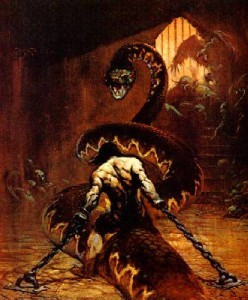 Bill: We remarked last week that, in some ways, “The Tower of the Elephant” was anticipated by “The God in the Bowl:” both show a youthful Conan running afoul of civilization while rubbing elbows with alien gods. While “The God in the Bowl” had some pacing and structural issues that detracted from the overall effect, “The Tower of the Elephant” was smooth as silk, taking all of the elements that were present in the earlier story and bringing them to new heights. I think a similar parallel can be drawn between “The Phoenix on the Sword” and this week’s story, “The Scarlet Citadel,” stories featuring Conan as King of Aquilonia and bane of wizards and politicians alike.
Bill: We remarked last week that, in some ways, “The Tower of the Elephant” was anticipated by “The God in the Bowl:” both show a youthful Conan running afoul of civilization while rubbing elbows with alien gods. While “The God in the Bowl” had some pacing and structural issues that detracted from the overall effect, “The Tower of the Elephant” was smooth as silk, taking all of the elements that were present in the earlier story and bringing them to new heights. I think a similar parallel can be drawn between “The Phoenix on the Sword” and this week’s story, “The Scarlet Citadel,” stories featuring Conan as King of Aquilonia and bane of wizards and politicians alike.
The tale begins in the midst of blood and thunder with the remnants of a battle. Conan and the pick of his knights have been led into an ambush and betrayed and the King, much as the youth had once before in “The Frost-Giant’s Daughter,” finds himself the last survivor on the battlefield. It’s a tremendous opener, both from the vivid descriptive power and the defiant, indomitable spirit of Conan.

Robert E. Howard
Howard: There are so many great visual details in that opening. Writers should take note, again, of Howard’s flawless ability with establishing shots. Pinpoint details in amongst the sweeping prose give us an entire battle that would have taken millions of dollars and a team of animators to show on film.
Bill: Even after Conan is subdued by the poison of his wizardly antagonist and brought into his enemy’s Scarlet Citadel, he remains defiant in the face of certain death. When Tsotha-lanti offers the Cimmerian his freedom and some ready coin to sign away his claims to Aquilonia and depart, the former barbarian wanderer gives an answer only a true King could.
Howard: I’d forgotten how long Tsotha-Lanti permits Conan to speak, and was sort of surprised that he didn’t cut him off before he could finish talking — he goes on for several paragraphs. But then this isn’t quite the same sort of tale as “The Tower of the Elephant.” Last week J.C. Hocking, in the comment section, rightly called that one mythic. This one isn’t mythic, it’s purple with capital A adventure, with almost everything taken to 11. Even the speeches are grand and a little over the top. It’s a thrill ride from start to finish and delivers everything in spades. Think how boring that dungeon would have been in the hands of a lesser writer! Think how boring dungeons have been since in the hands of lesser writers…
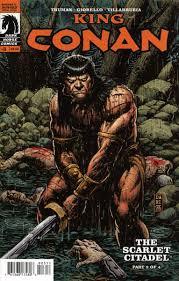 Bill: Most definitely. REH stocks Tsotha-lanti’s dungeon with a cornucopia of weird in the form of several strange monsters, a brain-eating plant rooted in hell, an imprisoned wizard, the resurrection of one of Conan’s freshly slain captors, and a flying creature of ancient provenance. Here we have the King reduced to his own personal ingenuity, weaponless and bound and fed to monsters — something that only the barbarian at the heart of the man could hope to survive. Indeed, the spark of Conan’s escape is provided by his own barbarian infamy — when one of his jailers seeks revenge against “Amra” for the slaying of his brother, he blunders within killing range of the giant snake set to make a ready meal of Conan. (Incidentally we get another taste of foreshadowing here, as the very next story will feature Conan as a southern pirate).
Bill: Most definitely. REH stocks Tsotha-lanti’s dungeon with a cornucopia of weird in the form of several strange monsters, a brain-eating plant rooted in hell, an imprisoned wizard, the resurrection of one of Conan’s freshly slain captors, and a flying creature of ancient provenance. Here we have the King reduced to his own personal ingenuity, weaponless and bound and fed to monsters — something that only the barbarian at the heart of the man could hope to survive. Indeed, the spark of Conan’s escape is provided by his own barbarian infamy — when one of his jailers seeks revenge against “Amra” for the slaying of his brother, he blunders within killing range of the giant snake set to make a ready meal of Conan. (Incidentally we get another taste of foreshadowing here, as the very next story will feature Conan as a southern pirate).
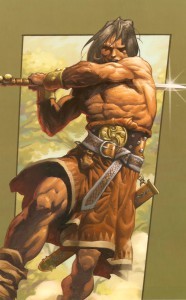 Howard: Nice eyes, Bill. That this was a segue of a kind into the next tale hadn’t occurred to me, but it speaks again to how much better it is to read these stories in the order they were written rather than in a chronology imposed later. I think it’s worth pointing out that Conan here meets a “good” wizard, a rare incident in a Conan story. Except that Pelias might not be so much good as honorable, in a sense. Pelias feels indebted to Conan because Conan freed him, and then is disposed to help in any case because Pelias wants vengeance. Still, he actually seems like a decent fellow whose gratitude is sincere, which is why the moment with the giant snake is so marvelous. That thing is the terror of the entire dungeon, and yet it flees in fear when it beholds Pelias because it sees the wizard’s soul. I’d say that was my favorite bit with the wizard, except that there’s a wonderful disquieting moment when Pelias raises the dead man to open the gate, or that brilliant part at the end where Tsotha’s body races after the head borne by Pelias’ minion…
Howard: Nice eyes, Bill. That this was a segue of a kind into the next tale hadn’t occurred to me, but it speaks again to how much better it is to read these stories in the order they were written rather than in a chronology imposed later. I think it’s worth pointing out that Conan here meets a “good” wizard, a rare incident in a Conan story. Except that Pelias might not be so much good as honorable, in a sense. Pelias feels indebted to Conan because Conan freed him, and then is disposed to help in any case because Pelias wants vengeance. Still, he actually seems like a decent fellow whose gratitude is sincere, which is why the moment with the giant snake is so marvelous. That thing is the terror of the entire dungeon, and yet it flees in fear when it beholds Pelias because it sees the wizard’s soul. I’d say that was my favorite bit with the wizard, except that there’s a wonderful disquieting moment when Pelias raises the dead man to open the gate, or that brilliant part at the end where Tsotha’s body races after the head borne by Pelias’ minion…
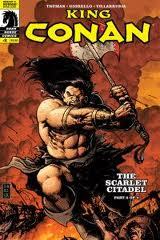 Really, this whole story is full of great moments, flowing one after the other. Like I said, a thrill ride, with energetic and visually gripping prose.
Really, this whole story is full of great moments, flowing one after the other. Like I said, a thrill ride, with energetic and visually gripping prose.
Bill: I love how this section gives us the “lone warrior vs. the weird” element before Conan is once again thrust back at the head of his Kingdom and ready for an epic confrontation with Tsotha-lanti and company’s forces. I’ve heard it said that all stories are either The Iliad or The Odyssey, or some combination of the two. Much as Vergil did in his own great celebration of the epic tradition, REH here is shooting for a balance between those elements. Conan is a wily and exiled adventurer in the mold of Odysseus while in Tsotha-lanti’s dungeon, living by his wits, encountering strange beasts, making powerful allies. When he returns to Aquilonia he is Achilles and Agamemnon, wrath and rule, a decider of the fates of kingdoms. These things are not easy to balance! REH is showing such a deft touch at mingling these approaches that we get something seamless and organic, not merely a plot that moves, but a tale that shifts gears while preserving its tone.
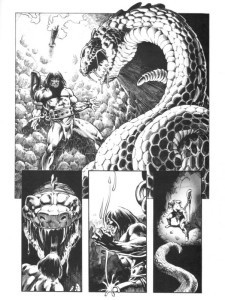 Howard: To quote a certain wall-crashing beverage pitcher, “oh yeah.” The tone throughout is dead-on, and if a work should be judged in part by whether or not it achieves what it sets out to do, this is a ten. It’s a juggernaut of momentum, layered with fantastic twists and scenes of dread and wild imagination.
Howard: To quote a certain wall-crashing beverage pitcher, “oh yeah.” The tone throughout is dead-on, and if a work should be judged in part by whether or not it achieves what it sets out to do, this is a ten. It’s a juggernaut of momentum, layered with fantastic twists and scenes of dread and wild imagination.
I’d never heard than about The Iliad or The Odyssey; I’ll have to give that some thought.
Bill: What really recalled to mind “The Phoenix on the Sword” to me was the section that covered the chaos in Aquilonia’s capital when the news of Conan’s death reached it. The details of the political intriguing, a venal nobleman stepping forth to vie for the crown, the downtrodden people revolting, the nobles slinking away to their country estates, has the sweep of historical epic, and all rang true. The culmination of the scene, Conan’s dramatic return and destruction of his usurper, shines out with all the poetic logic of a legend.
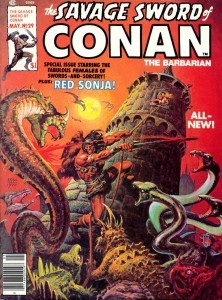 And then we get to the climax, another concise and economical section that nonetheless seems to pack in as much story as a longer work. REH again shows how to paint a vivid scene without padding the word count, first in the desperate siege of Shamar and then with Conan’s counterattack. The battle that sees Tsotha-lanti and his allies defeated shows us Conan as strategist in the vein of the Black Prince — breaking his opponent’s army with massed ranged firepower. The barbarian, angry and righteously revengeful, is still smart and controlled and in command.
And then we get to the climax, another concise and economical section that nonetheless seems to pack in as much story as a longer work. REH again shows how to paint a vivid scene without padding the word count, first in the desperate siege of Shamar and then with Conan’s counterattack. The battle that sees Tsotha-lanti and his allies defeated shows us Conan as strategist in the vein of the Black Prince — breaking his opponent’s army with massed ranged firepower. The barbarian, angry and righteously revengeful, is still smart and controlled and in command.
Howard: Is anyone tired of me saying that REH was simply masterful at writing of massed combat and making it interesting? And somehow he shows us the important individuals within that combat at the same time he’s showing us the mighty armies. Whenever I sit down to write a huge battle scene I try always to revisit a little Howard beforehand just to study a master at work.
Bill: He’s superb. And the final scene, Conan leaping his horse from barge to barge as the enemy’s bridge of boats breaks up and a desperate Tsotha-lanti tries to escape, is another tremendous touch. The immortal wizard’s comeuppance, in the form of a decapitation that sees his head carried away by Pelias in hawk form, while the body runs after it, contains a sardonic element of grim humor neither out of place in a Texas tall tale or a classical myth.
In the end, REH delivers another classic Conan tale hot on the heels of the last and, in reading each of these stories in the order they were written, you can really see REH collecting the various strands of his character and world and working at them until they click. And man, do these stories click!
Howard: They certainly do. And next week one of them spreads its sails. We’ll be reading “Queen of the Black Coast.” We hope to see you here!
September 2, 2015
Conan Graphic Novels
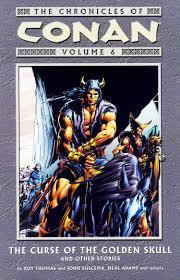 I’ve come down with an odd recurring fever. I’ll be perfectly miserable for hours, then it will break, and I’ll think I’m on the mend… only to have the damned thing come back. It’s really messing with my ability to get writing and house work finished. Also it’s uncomfortable.
I’ve come down with an odd recurring fever. I’ll be perfectly miserable for hours, then it will break, and I’ll think I’m on the mend… only to have the damned thing come back. It’s really messing with my ability to get writing and house work finished. Also it’s uncomfortable.
The one bright spot is that I’ve finally been able to read the old Marvel Conan comics, written/adapted by Roy Thomas. The local library has a pretty complete collection. I never read these when I was a kid (no idea why) so I’m coming upon them very fresh, and it turns out that they’re really fun sword-and-sorcery comics.
I started reading with volume 6, which is when Roy Thomas himself writes that he felt like he really had a handle on what he was doing.
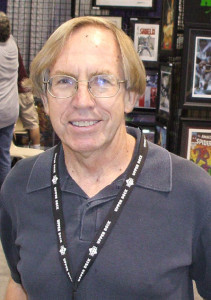
Roy Thomas
You know, I came upon Harold Lamb and Robert E. Howard backwards from the way people normally do — I’d read thousands of pages of Harold Lamb before I ever seriously read Robert E. Howard. And I’ve come to these Thomas Conan comics backwards as well, because I started by reading the year’s worth of Conan comics he wrote for Dark Horse. I thought them better conceived than most of the other graphic novel collections from the new Dark Horse line (as a matter of fact, they’re two out of only three of those Conan graphic novels that I’ve kept).
So I figured I might enjoy these others, written decades before, and I am. When I woke last night with more aches and chills and couldn’t sleep, I just sat down to enjoy another tale of my favorite Cimmerian. After polishing off two collections I think I can safely say that Roy Thomas is one of the best REH pastiche writers we’ve had. It doesn’t hurt that Sal Buscema drew the stories with such vigor and detail, either.
Howard Andrew Jones's Blog
- Howard Andrew Jones's profile
- 368 followers



